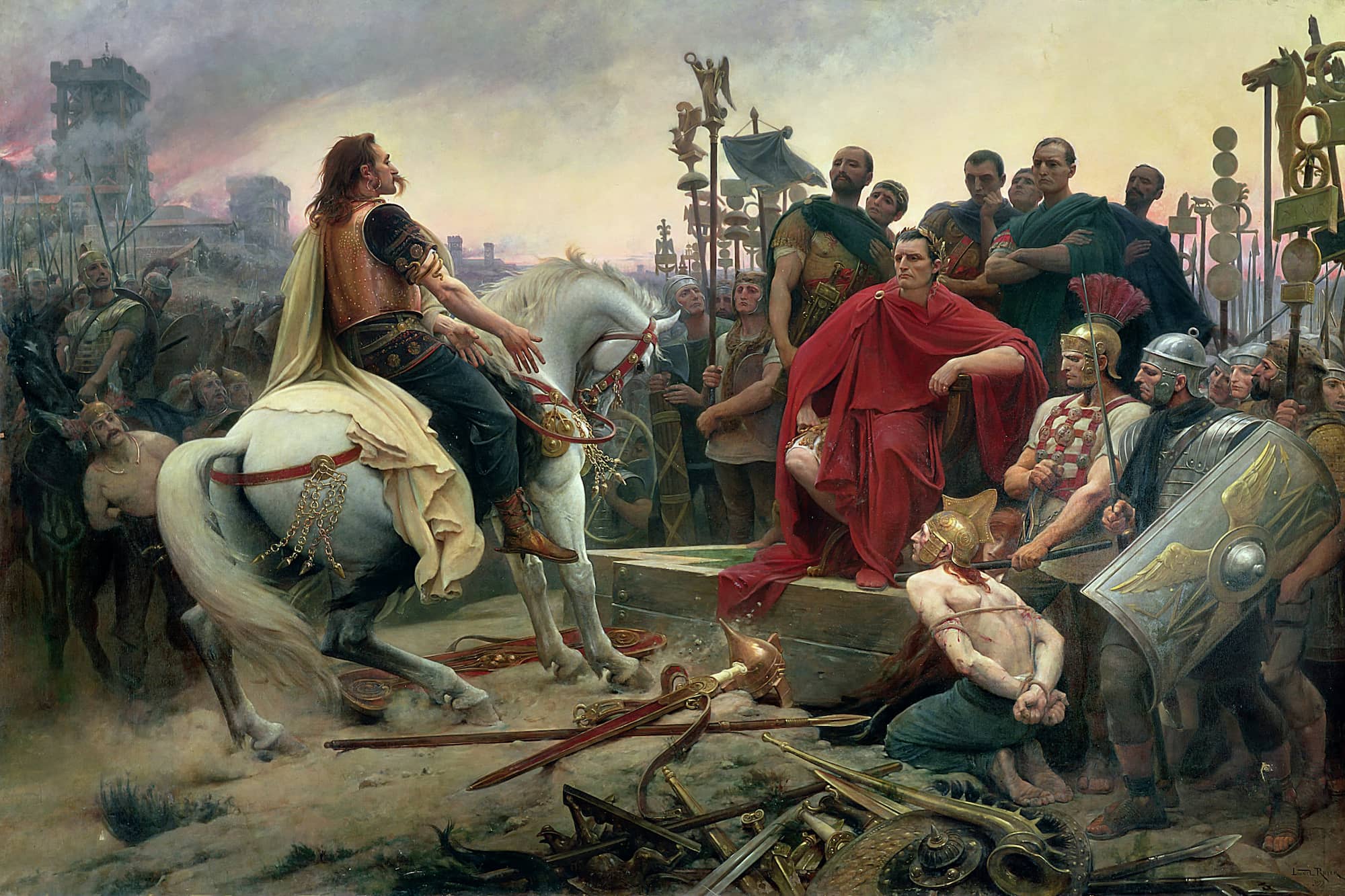In antiquity, the Gallic Wars corresponds to the Roman conquest of Gaul, a territory roughly equivalent to present-day France, as well as Belgium, the Netherlands, parts of Germany, Luxembourg, and Northern Italy. Gaul was then composed of numerous populations with different customs and laws. During this war, Vercingetorix managed to unite the Gauls, who faced the Romans in two major battles: Gergovia, where the Gauls emerged victorious, and Alesia, marking their definitive defeat.
- Why Was the Gallic Wars Fought?
- Where and When Did the Gallic Wars Take Place?
- Which Gallic Peoples Were Subdued by Julius Caesar?
- Why Did Julius Caesar Write the Book Gallic Wars?
- What Was Vercingetorix’s Role in the Gallic Wars?
- Why and How Did the Gauls Lose the Gallic Wars?
- What Were the Consequences of the Gallic Wars?
Julius Caesar conquered Gaul in less than 8 years, from 58 to 50 BCE, with approximately 100,000 men. Caesar himself narrates this campaign in his work titled “Commentarii de Bello Gallico (Commentaries on the Gallic War),” portraying himself as an inspired and victorious leader to appeal to the Senate, to whom he was accountable. It is worth noting that this war, ostensibly aimed at protecting Rome and its allies, also served the purpose of advancing the proconsul’s political career, bringing military glory, and settling his debts.
Key Battles of the Gallic Wars
- Battle of the Arar (58 BC): Caesar’s first major battle against the Helvetii tribe, a Germanic Celtic tribe, resulting in a decisive Roman victory.
- Battle of Bibracte (58 BC): Another battle against the Helvetii, fought near the Mont Beuvray in present-day Burgundy. The Romans, led by Caesar, emerged victorious.
- Battle of Vosges (58 BC): An engagement during the pursuit of Vercingetorix, where Caesar achieved a victory over the rebellious Gallic chieftain.
- Battle of the Axona (57 BC): Engagement against the Belgae confederation, where Caesar successfully defeated the forces of the Belgic tribes.
- Battle of the Sabis (57 BC): An encounter with the Germanic Suebi tribe led by Ariovistus, resulting in a victory for Caesar and securing Roman influence over the region.
- Battle of Lutetia (52 BC): A skirmish fought near present-day Paris during the rebellion.
- Battle of Gergovia (52 BC): A significant defeat for Caesar against the united Gallic tribes led by Vercingetorix. This marked a rare setback for Caesar in the course of the war.
- Siege of Alesia (52 BC): A decisive siege where Caesar’s forces surrounded and defeated Vercingetorix and his Gallic allies, effectively ending organized Gallic resistance.
- Battle of Gergovia (52 BC): Following the siege of Alesia, Caesar faced further resistance at Gergovia but ultimately succeeded in capturing the city.
- Battle of Alesia (52 BC): Not to be confused with the Siege of Alesia, this earlier battle was part of Vercingetorix’s rebellion. Caesar emerged victorious, further establishing Roman dominance.
Why Was the Gallic Wars Fought?
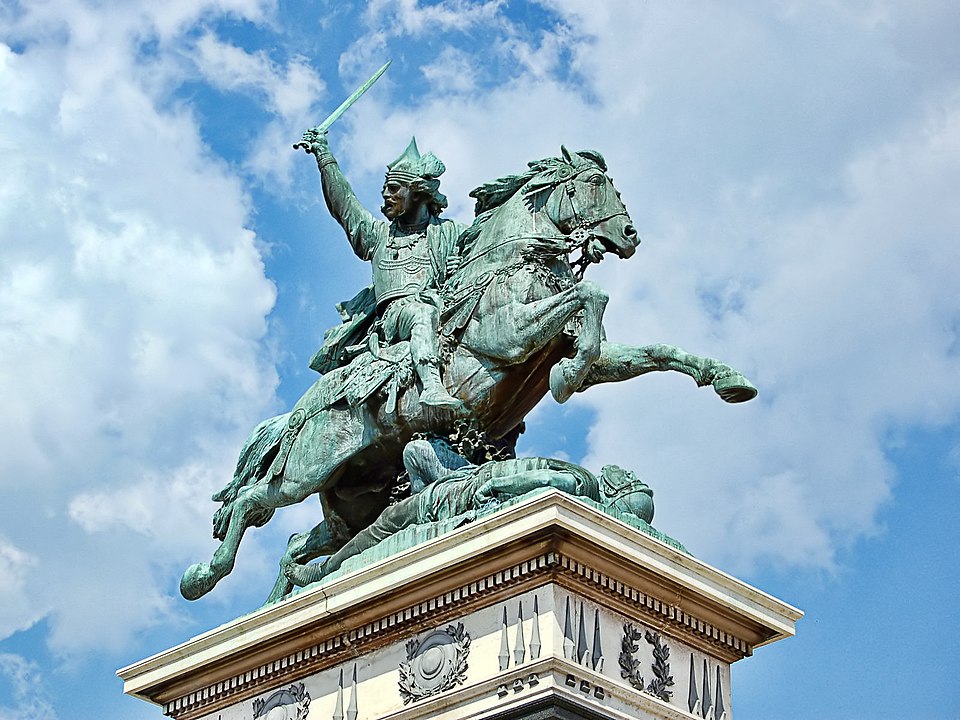
The causes of the Gallic Wars are manifold. Some Gallic tribes could potentially pose a threat to the Roman Republic, but Julius Caesar had much to gain from it. In his Commentaries on the Gallic Wars, Caesar justifies each of his campaigns in Gaul as a pacifying mission or as assistance to a threatened tribe. According to his rhetoric, Caesar is not conquering; he is protecting the weaker ones. It is true that the Aedui, an allied tribe of the Romans, seek Roman support against the Helvetii, who have decided to join Aquitaine.
Rome already had a foothold in the southern Gaulish territory, in Gallia Narbonensis (Transalpine Gaul), and allies among these peoples. Furthermore, Rome worries that the opportunistic and belligerent Germanic peoples might invade the Helvetii’s territory. However, Julius Caesar saw this primarily as an opportunity to gain military glory over Pompey and Crassus, fellow members of the triumvirate with him, who jointly led Rome.
Support for the Aedui elicits hostile reactions from other tribes, and Caesar eventually deems it necessary to conquer the entirety of Gaul to pacify the region. Every pretext is used to defend the interests of Rome. Between preventive action and the desire for glory, the Gallic Wars conveniently serves Julius Caesar, who seizes the opportunity.
Where and When Did the Gallic Wars Take Place?
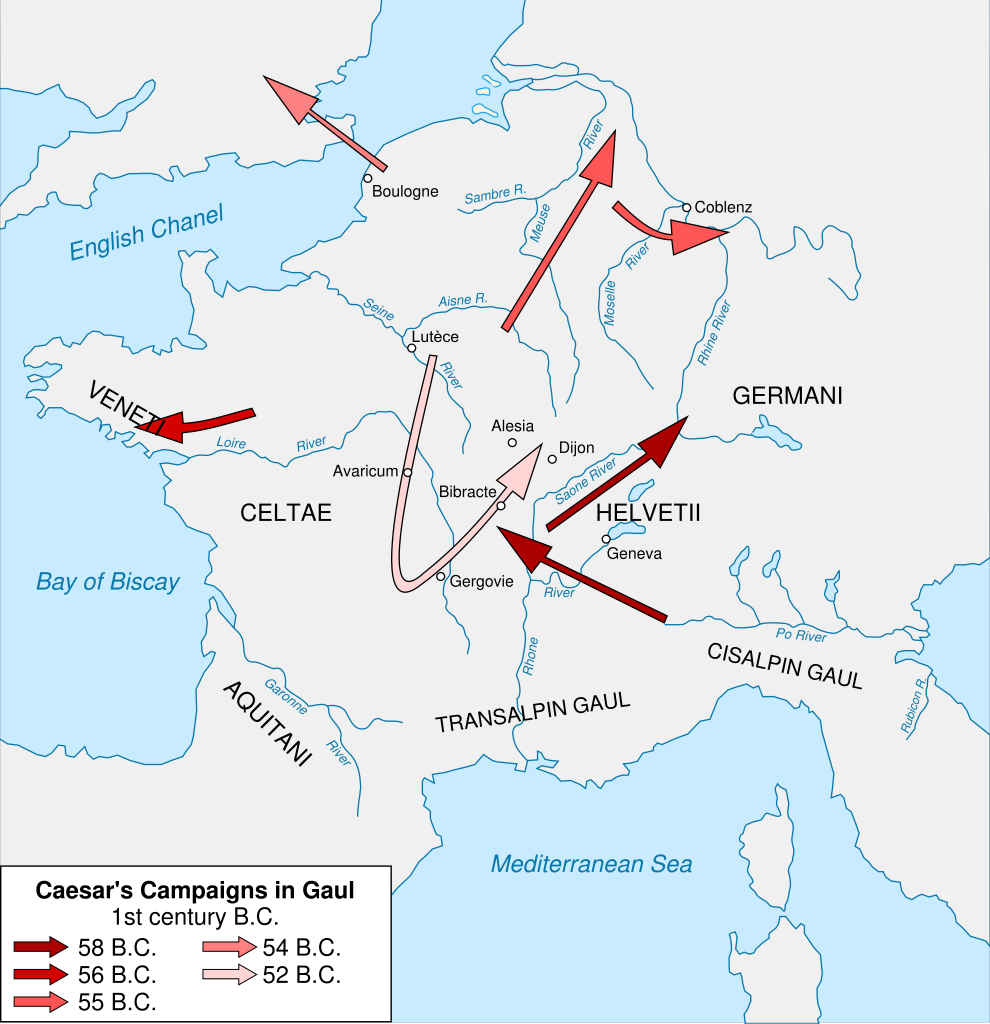
The Gallic Wars took the form of a series of military campaigns directed against various Gallic tribes that then constituted the territory. Initially, the objective was to contain the Helvetii, which was accomplished in two campaigns during the same year, 58 BC. The following year, Julius Caesar turned his attention to the Belgians, who had raised an army of allied tribes. The proconsul gradually subdues the different peoples of Belgic Gaul. Military operations continued in Britain and then in Aquitaine. In 55 BC, Germanic tribes threatened the last Belgian tribes subjected to Rome. The formidable Germanic peoples put up a strong resistance before Caesar managed to cross the Rhine, a technical feat achieved through the construction of a bridge.
Julius Caesar then set his sights on Britain (modern-day Great Britain), accused of sending reinforcements during minor Gallic uprisings. This opportunity allowed the general to regain favor in Rome after the challenges faced by the Germanic peoples. Caesar is subsequently harassed by various revolts, necessitating his intervention across the region. He is compelled to continue fighting, while Pompey, with whom rivalry intensifies, is in Rome at the heart of power. However, Pompey lends him legions for reinforcement. The only tribes left to conquer in 53 BC were the Treveri, Menapii, and Eburones, under the leadership of Ambiorix. It is through the ingenuity of Lieutenant Titus Labienus that Julius Caesar achieves this.
In 52 BC, a new revolt looms. The massacre of Cenabum, executed by the Carnutes, sparks rebellious sentiments throughout Gaul. Under Vercingetorix, of Arvernian origin, many Gauls unite. After a defeat at Avaricum, the Gallic leader is victorious at the Battle of Gergovia before eventually surrendering in the Battle of Alesia. The Bituriges and then the Carnutes rise again the following year. However, the last resistors to Roman domination were defeated during the Siege of Uxellodunum in 51 BC. Julius Caesar, adorned with glory, finally returned to Rome to seize power. Crossing the Rubicon with a legion, he triggered the Civil War in 49 BC.
Which Gallic Peoples Were Subdued by Julius Caesar?
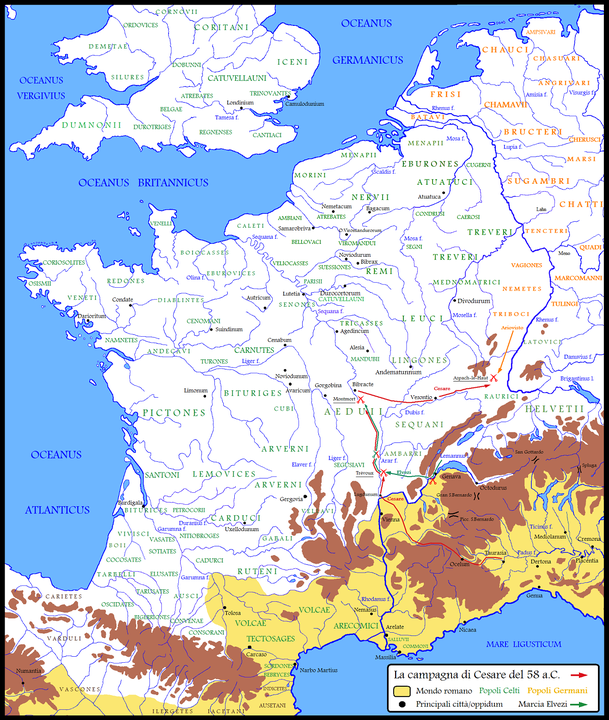
During the Gallic War, Julius Caesar subdued many Gallic peoples, often facing repeated resistance as different tribes continued to revolt:
- 58 BC: the Helvetii, towards present-day Switzerland;
- 57 BC: the Nervii, Atrebates, and Viromandui, towards present-day Belgium;
- 56 BC: the Armoricans and Venelli, towards present-day Brittany;
- 55 BC: the Morini and Menapii towards Belgium, the Usipetes and Tencteri towards the Rhine;
- 54 BC: the Breton coalition;
- 53 BC: the Eburones, in the northeast of Gaul;
- 52 BC: the Arverni, Sequani, and Parisii, in the central-eastern part of Gaul and towards present-day Paris;
- 51 BC: the Bellovaci (towards Belgium), the Pictones (towards present-day Poitou), the Bituriges (Celtic Gaul between the Loire and the Massif Central), the Cadurci (around Cahors), the Treveri (Gaul Belgium), and the Carnutes (Beauce).
Why Did Julius Caesar Write the Book Gallic Wars?
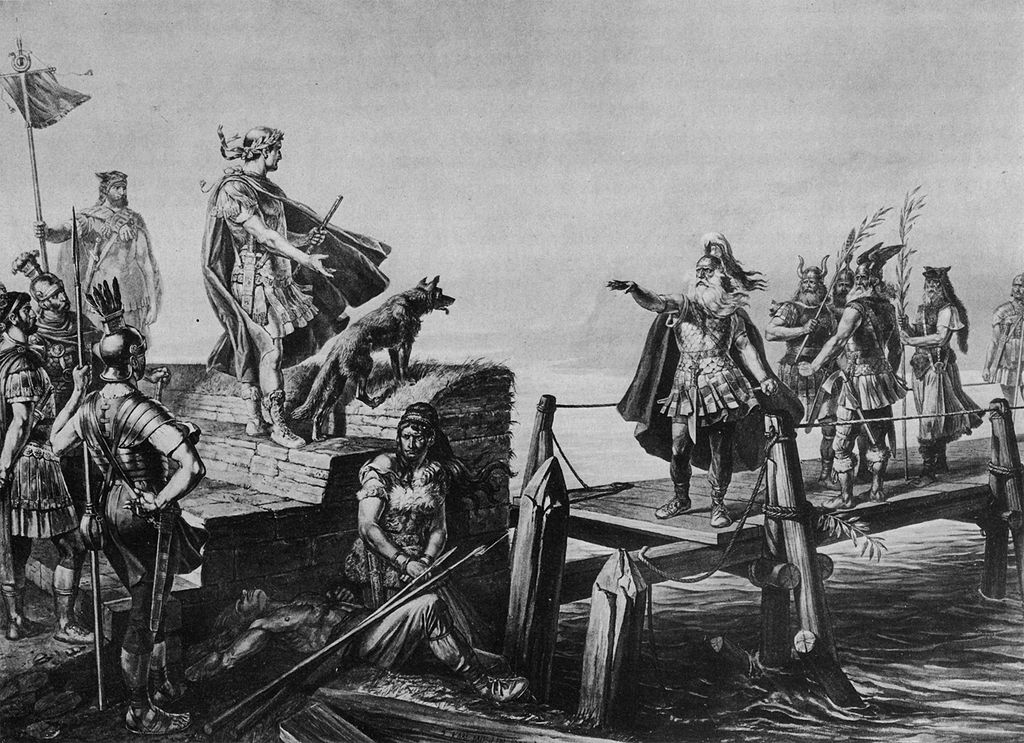
The primary account of the Gallic War comes from Julius Caesar himself, who is both the judge and the party involved, as he writes about it. His Commentaries on the Gallic Wars were divided into seven volumes, one for each year of the military campaign. They were regularly published in Rome in batches of two or three volumes. Aulus Hirtius, a close friend of Julius Caesar, will write an eighth book to describe the situation in Gaul in 50 BC and the final conflicts in 51 BC.
While Caesar and Aulus Hirtius consider these works as historical documents, one must approach the pages with a critical perspective, keeping in mind that the author is not neutral and consistently portrays himself in a favorable light.
When Caesar depicts his adversaries as formidable and challenging to defeat, it is to highlight his own victory and downplay the role of his lieutenants. Julius Caesar sought glory during the Gallic Wars and aimed to persuade the Roman aristocracy, through his Commentaries, that his military campaigns were justified. These are indeed commentaries, concise remarks that stick to the facts in the form of raw notes.
Cicero praises Caesar’s straightforward and effective writing style. However, a certain level of caution is warranted when interpreting these writings. Many individuals who participated in the war, particularly the lieutenants, could testify in cases of falsehood. The complete text of The Gallic Wars is available online.
What Was Vercingetorix’s Role in the Gallic Wars?
An Arvernian named Vercingetorix led the largest uprising of the Gallic tribes. It all begins with the massacre of Cenabum on January 23, 52 BC, where the Carnutes executed Roman citizens. The entire Gaul was inflamed following this event. A nobleman newly in power, Vercingetorix takes the lead in the rebellion and gathers the Senones, Parisii, Pictones, Cadurci, Turones, Aulerci, Lemovices, Andes, and other clans from the oceanic border, as well as the Bituriges.
Having previously served in the Roman army, Vercingetorix employs their strategies. He adopted the scorched-earth policy of destroying cities and fields to hinder the Roman army’s supply lines. After the Gallic defeat at Avaricum, resulting in a massacre, Vercingetorix’s forces retreat to the oppidum of Gergovia.
Despite successfully foiling the betrayal by the Aedui, the Romans abandoned the siege after significant losses in skirmishes. They head towards Lutetia to confront the Parisii, Senones, and Aulerci. The entire Gaul revolts at this moment and unites behind Vercingetorix at Bibracte, except for the Remi, Lingones, and Treviri. In August 52 BC, Vercingetorix attempted to crush the Roman troops but was forced to retreat to Alesia, where he eventually surrendered.
Why and How Did the Gauls Lose the Gallic Wars?
The defeat of Vercingetorix took place in September 52 BC at Alesia, where 95,000 Gauls were entrenched in the oppidum and resisted a siege. Julius Caesar undertook significant encirclement works to prevent the Gauls from going out to resupply. The idea was also to make combat more challenging for the Gauls during their skirmish attempts. The Gallic relief army was insufficient to free Vercingetorix and his troops.
The vast multitude of Gallic tribes, often divided, tended to betray each other regularly. It was also through the Germanic cavalry that the Romans managed to win the final battle. The Romans had indeed enlisted German mercenaries to tilt the odds in their favor.
Key Dates in the Gallic Wars
- 58 BC: Caesar Annexes Switzerland: Julius Caesar invades the land and manages to assert his authority over the Helvetii people. Roman dominance gradually extended across the entire territory, which takes on the name Helvetia. Initially, it fell under the province of Belgica before being integrated into the Gallia Lugdunensis.
- 57 BC: Julius Caesar Subdues the Belgian Territory: Caesar managed to subdue the Celtic and Germanic peoples of Belgium despite fierce resistance and uprisings. Roman Belgium then encompassed a much larger territory than it would later become. It is divided into three provinces: Belgica Prima, Germania Inferior (Germania Secunda), and Belgica Secunda. The region experienced some development, and significant cities were founded (Tournai, Tongres).
In the years to come, it will be marked in the north by the presence of Frankish Germans (future Flemish) and in the south by a population of more Latinized Franks (future Walloons). - 52 BC: The Siege of Gergovia: Located in the Arverni region, Gergovia was the site of a major battle in the Gallic Wars. The Arverni and Bituriges tribes, which Vercingetorix led, won the battle with the Romans. Julius Caesar had six legions in addition to his Gallic allies, especially the Aedui. To conceal his defeat from the Senate, Caesar pretends to prefer supporting his lieutenant Labienus further north.
- May 52 BC: The Romans Capture Lutetia: Lutetia, which the Romans, under the command of Lieutenant Labenius, have held since the third century BCE, falls into their hands. Residents of the fortified city destroy it because they won’t give up to the invaders. This action allowed the Romans to quickly spread their own architecture. The Gaulish people gave the city the name Paris, which the Romans called “Civitas Parisorium,” or the city of the Parisii.
- 52 BC: The Battle of Alesia: The Siege of Alesia lasted 6 to 8 weeks. Vercingetorix and his troops retreated to this oppidum after the failure of an attack that was meant to be decisive. In response, Caesar built significant fortifications that greatly hindered the Gauls. Furthermore, reinforcements are delayed, arriving only after 6 weeks. The Romans eventually prevailed, thanks to Germanic reinforcements.
What Were the Consequences of the Gallic Wars?
The Gallic Wars marked the beginning of Rome’s significant expansion and the onset of the civil war in Rome, known as Caesar’s Civil War, pitting Julius Caesar against Pompey. Following his victory in Gaul, Julius Caesar returned to Italy with great prestige, seizing power as imperator and later as dictator for life, thereby ending the Roman Republic in favor of the Roman Empire.
In Gaul, an entire civilization undergoes transformation, as Caesar’s triumph gives rise to Gallo-Roman culture, leaving enduring legacies evident today in various aspects such as roads, architecture, law, and other elements resulting from the Roman conquest of Gaul.


